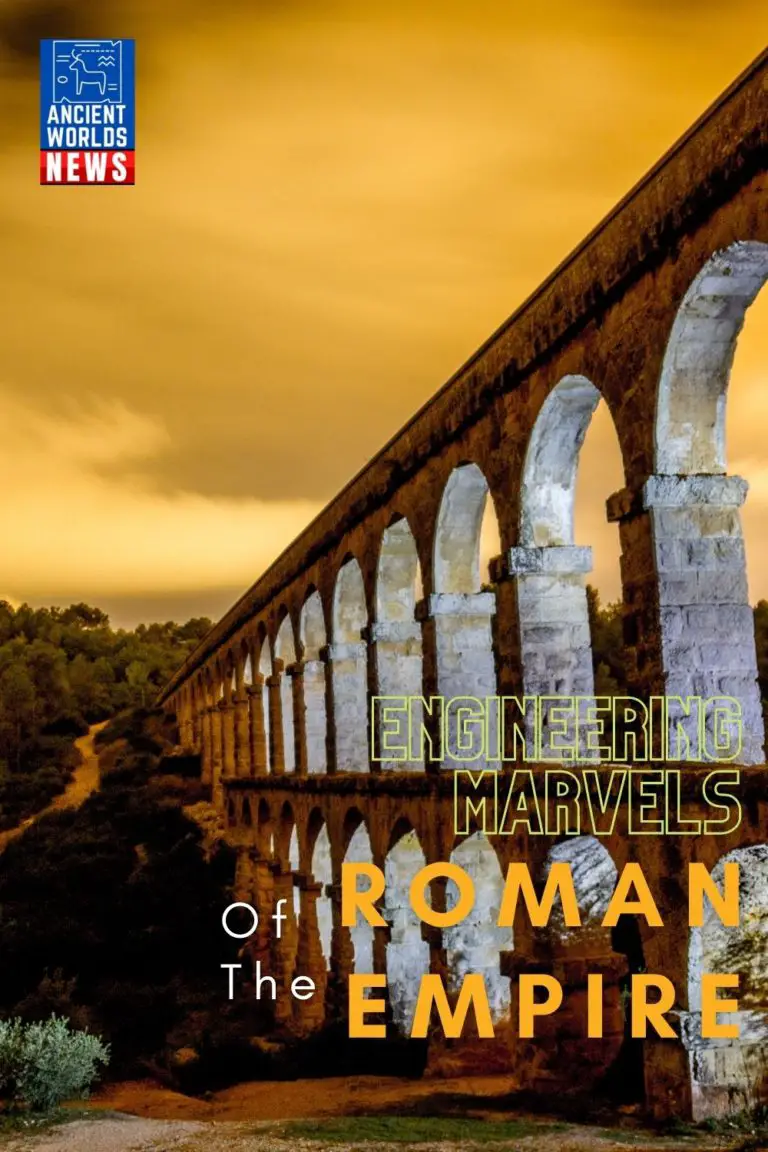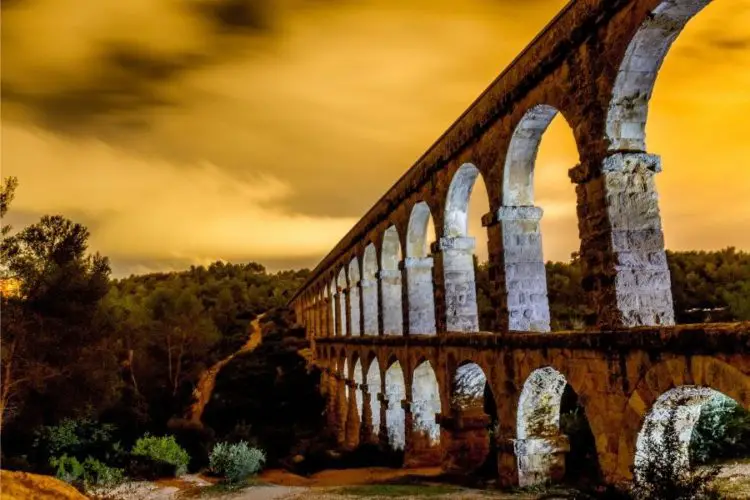Ancient Roman engineering was what gave them the upper hand in all of Europe. Even though aqueducts were already present before the Romans built more, Roman engineering was popularized because of its innovations. Roman engineering made life easier for its people as it brought water into the cities from far away rivers. Rome’s citizens were living a fulfilled and abundant life of comfort even before modernization. Romans used their concrete to build magnificent structures, some of which still stand tall and firm even now. Some aspects of Roman architecture were influenced by the Etruscan and Greek civilizations.

Roads that Survived
Roads are something common that we see every day. But what was special about Roman roads? Roman roads were built keeping in mind any obstacle that could harm them, like floods. Roads had a slight inclination towards the side in order to let rainwater pass. There was a draining system for rainwater and floodwater to pass without causing much trouble for civilians. Roads were built with such high-quality materials that some of them are still functioning well. Due to multiple layer construction, roads needed very little maintenance over time.
Roads were used for transportation, and they were also used to maintain control over territories. The roads were built as straight as possible for connecting two cities. Back then, cities were far away and there were not many transportation options. Most people traveled by foot. Laying out the network of roads was complicated because bridges and tunnels had to be built as well.
Before building a road, land needed to be excavated. Then materials would be brought from long distances to fill the excavation sites. Curb stones were set in the excavated land and deep holes were made between large stones. These deep holes were filled with gravel or rocks. A layer of fine gravel was added to the previously compacted gravel layer. The roads were finalized by putting large rock slabs on the top. Gravel layers underneath protected roads from freezing or getting ruined during floods or heavy rain. Milestones were also a part of building roads. After every mile, a milestone was situated that indicated the distance of the city or place one was going to.
The functionality of roads meant everything to the Romans. A significant amount of their lives depended on it. They built 29 highways leading in and out of the city.
Bridges with Curved Stones
Romans can be considered the first to understand the advantages of an arch. They were the first to build bridges. Pons Aemilius, a bridge built by Romans, was 443 feet long. Initially, bridges were built using stone slabs and connecting them together with iron clamps. Innovation in bridge making brought about concrete and rock bridges. The entire structure was made of concrete, from the bridge to supporting pillars. Roman engineers used cofferdams, which were made of wood shreds and clay. This structure was then filled with concrete to make pillars.
The arch structure made bridges stronger. Alcantra Bridge is 597 ft long and is still standing. If you visit Europe, you will see hundreds of bridges still standing strong, representing the high-quality engineering work of the Romans. Ponte Rotto was built in 142 BC and is the oldest stone bridge in Rome.
Aqueducts to Fulfill the Need for Water
The construction of large aqueducts was done to bring a large amount of water into cities. Eleven aqueducts brought 260,000 gallons of water into the city every day. Water was used by civilians in baths, toilets, and other water-related activities. Sextus Julius Frontinus wrote a report for the emperor about the conditions of the aqueducts of Rome during the end of the 1st century AD.
Roman engineers brought innovation to the structure of already existing aqueducts to get the most advantage out of them. Aqua Appia was the first aqueduct built in Rome 312 BCE. Aqueducts had tunnels, pipelines, and conduits to let the water flow from springs and rivers into the cities. Water pipes took water to fountains, public baths, and the houses of nobles. Power mills and other machines were also given a water supply using aqueducts. Roman engineers used arcades to transport water to valleys and low ground levels. Romans also built water tanks using waterproof concrete. These tanks were fixed at a regular distance to keep the water supply functioning. Aqueducts had to be maintained regularly because regular water supply could easily damage them in the long run. Slaves did the maintenance work. The aqueducts network was complex, but it ensured a regular supply of water into the city.
Aqueducts were as long as 100 km and 1,000 feet above sea level. Roman civilization was the first civilization that understood the true power of water. They built watermills for the grinding floors. A good example of a watermill can be seen in Barbegal where 16 mills were powered by only one aqueduct. The water quantity matched the water usage of modern big cities like Modern Rome or New York.
Tunnels to Remove Obstacles from the Path of Great Constructions
To build roadways, bridges, and aqueducts, engineers had to make tunnels. These tunnels were made whenever they faced issues such as mountains or hills. Engineers had to make sure that both ends of a tunnel met at the center. It was complex work because excavating could take years to make a tunnel.
There were multiple ways of constructing a tunnel, and each of them required a lot of pre-planning and a good understanding of geometry. Surveyors had to check on tunnels regularly to make sure they were going in the right direction. Keeping tunnels ventilated was another issue that Romans faced. Tunnel-making depended on the type of tunnel and the type of stone that was being excavated. To break the hard rocks, Romans used a fire-quenching technique that required the stone be heated and then cooled so it would crack. Even with thousands of workers, tunnel-making could take years. During the time of the emperor Claudius, the 6 km tunnel to drain out Fucine Lake was built in 11 years, even with 30,000 workers.
Mines to Excavate Hidden Jewels
Ancient Romans used modern techniques to mine for valuables. Mining sites were surrounded by aqueducts and big water tanks. There was also water-powered machinery at the site that was used during mining. Water power was used for the hushing method in which water was released in a large quantity in order to remove the upper layer of the ground. Another technique used was a fire-quenching technique in which water was used to crack already heated rocks.
Roman mining technology can be seen at Dolaucothi in Great Britain and Las Medulas in Spain. The site at Dolaucothi has five aqueducts around it.
Water and fire methods were very effective. But the fire method was very dangerous, especially in underground mining.
Advanced Weapons to Defeat Enemies
Weapons were another thing that provided ancient Romans with the upper hand in Europe. These weapons were of advanced technology that gave Romans an advantage during every battle. Artillery weapons were the most advanced technology. A ballista (artillery weapons) consisted of two crossbows attached to one machine. Both of them could be released at the same time by pulling back the string that was attached to both winches. Roman engineering improved this machinery and made it lightweight. It became easier to assemble and use during battles. At close range, a ballista was very accurate. Engineers made carroballista (ballista attached on a cart), making the machine mobile.
Concrete and Other Materials
Concrete is another important aspect of Ancient Roman civilization. Without concrete, there would not be any bridges, roads, or aqueducts. Opus caementicium was invented in the late 3rd century BCE. It was a mixture of water, pozzolana, and mortar (mixture of rock, brick, and lime). The invention of concrete allowed Rome to built such great architecture.
Rome had a “concrete revolution” period during which it saw rapid advances in concrete development. They figured out how to make concrete waterproof; they also figured out how to make underwater concrete.
Roman concrete was superior to modern concrete. According to recent research, ancient concrete is still unaffected by seawater or any other environmental hazards, whereas modern concrete can see cracks in five decades.
Other than concrete, marble, brick and stone were used. Marble was mainly a decorative material. Bricks came in various shapes, such as curved brick and rectangular brick. Rectangular brick was used in walls and curved brick was used in columns. Marble was exported from Greece.
Ancient Roman engineering was what made ancient Roman civilization great. Their engineers were way ahead of time. The entire civilization spent its energy making lives easier and greater. They understood the need of having running water and concrete roads. Revolutionized engineering was the base of this great civilization.

